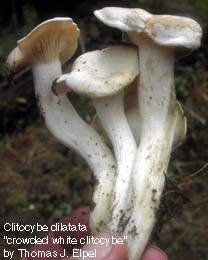
Tricholomataceae: The Pale-Spore Mushroom Family
The Pale-Spore Family, as the name suggests includes mushrooms with usually pale or white spores. Most species in the family are saprophytic, consuming old wood or forest duff. This is a large and diverse family; continuing research may cause some genera to be split into separate families.
I am most familiar with the fairy ring mushroom (Marasmius oreades), which is commonly found growing in a circular ring in lawns and meadows. The mushroom caps, smooth with a bulge in the center, always reminded me of chinese hats. I'm surprised I don't have a picture of them yet! Fairy rings are edible, although not outstanding mushrooms. My grandmother would ocassionally throw some in a soup, or dry them to use later in soups, but usually only if there were not any more exciting mushrooms available. One thing you do have to watch out for is the possibility that other species of mushrooms could be mixed in with a fairy ring. You have to take a moment to look at every one of them.
The crowded white clitocybe (Clitocybe dilatata) shown here is poisonous, and pretty much has that poisonous all-white look to it. The stem is mostly, but not always centered, and the gills are decurrent (running down the stem). It is typically found in clusters, often on the shoulder of forest roads in moist habitats in cool, even snowy fall weather. I found this one during a mushroom class at Rabbitstick Rendezvous in Rexburg, Idaho. There are more than two hundred species of Clitocybe in North America, and distinguishing between them can be difficult.
References:
Arora, David. All That the Rain Promises, and More... Ten Speed Press: Berkeley, CA. 1991.
Arora, David. Mushrooms Demystified, Second Edition. Ten Speed Press: Berkeley, CA. 1986.
Phillips, Roger. Mushrooms of North America. Little, Brown & Co.: Boston. 1991.
Schalkwijk-Barendsen, Helene M.E. Mushrooms of Northwest North America. Lone Pine Publishing: Redmond, WA. 1991.
-Check out my favorite mushroom guides.-
Return to the Wildflowers & Weeds Home Page.





 Wildflowers-and-Weeds.com
Wildflowers-and-Weeds.com 






